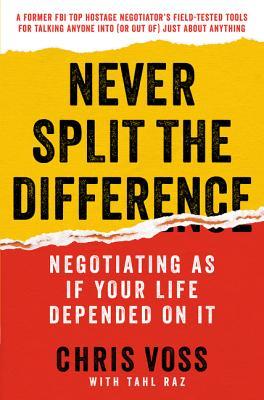
🔗 Link : Goodreads
⭐️ Rating: 6/10
🔗🚀 The Book in 3 Sentences
- A negotiation evolves around human emotion and not the subject itself.
- Winning a negotiation is about making the other person feel that he is in charge.
- Don’t try to “convince” the partner to a yes, but instead provoke a “no” to understand his position.
🔗🎨 Impressions
🔗Who Should Read It?
Everyone is faced with many negotiations in daily life, so we can all benefit.
🔗👷🏼 What do I apply to my life?
I occasionally apply the “How is this not fair’ (calibrated question) technique, when selling things.
I label emotions or mirror their statement with inflected voice to make the other person speak. Then be silent..
I acknowledge my mistakes first to give less room for negative dynamics against me.
🔗📒 Summary + Notes
🔗Read their expressions and make them talk
Pay attention to the body expressions and intonation.
Don’t rush to build up empathy.
Mirror the last words in a down inflected voice to question in a respective way and give the opponent time to regroup and encourage to reveal his strategy. Pause after labeling.
Express empathy by describing the other persons feelings: It seems like you are upset…
🔗Diffuse negative dynamics
First focus on the barriers and deny them or negative influences.
List the bad things before the other party can do it.
Diffuse negative dynamics by acknowledging errors deferentially : Look, I’m an asshole
🔗Don’t reach for a yes, provoke a no
A “yes” might mean counterfeit confirmation to get out of the situation. A “no” response makes the partner feel safe and in control. It also opens a discussion and gives the chance to hear what they want.
Engage the listener by triggering an obvious no.
Instead of asking “do u have a few minutes”, rather ask “is now a bad time”? (provokes a no… feels in control).
Ask questions that open the path to your goal: What did you think of? How do you see that?
🔗Dealing with rejection
If the business partners ignores you, contact them with a no orientated question, indicating that you are ready to walk away. People take more risks to avoid loss. So make rejecting the deal seem a loss.
When trying to convince someone. Ask kindly for the reason he doesn’t accept. Then label his perspective: So it seem like you could agree if..
🔗Negotiation psychology
Be transparent about deadlines. Otherwise you lose time, while the other party is hesitant to make concessions.
People reject a rationally fair offer if it doesn’t feel fair.
React to a response like “We made a fair offer” with a label. “Fair? “ it seems like you are willing to show how it’s fair..
Find the emotional driver of what the other party values: It’s not about child care, but a relaxed evening.. Negotiations often hinge on something other than money: self esteem, autonomy..
Instead of only focusing on the gains, address concerns and dangers: Instead of lowering the price of a new accounting system, offer help to impress the partners boss. Assure that you install it safely soon. Pivot to non-monetary values.
Use anchoring by putting an extreme range. The partner will tend to approach that range. Also, a range makes you sound less aggressive. Odd numbers make them seem more plausible.
Avoid requests that can be answered easily. Humans expect reciprocity.
Ask calibrated questions to negate the opponents offer: How am I supposed to do that? This will make the partner think about your solution and gives an illusion of control
Identify the counterparts negotiation style: accommodator (social), assertive (aggressive), analyst (think)
Punch back without anger. The counterpart is not the problem but the situation is.
Ackerman plan: Gradually increse the goal price to: 65, 85, 95, 100%.
Use precise non-round numbers to make the amount seem well-founded.
There are 3 types of leverage: positive (ability to give), negative (ability to hurt), normative (use the counterparts norms to convince).
🔗Steps for a negotiation
-
Set an optimistic but reasonable goal. Don’t fall back to the bottom line (just because you have a fallback option). It’s normal to concede everything beyond the other option if you have spent hours on it.
-
Be prepared: Why are you there? What do you want? What do they want? Why do they want that? You should be able to summarize the situation such as to get a “that’s right”.
-
Make a list of accusations the counterpart might make. Then turn each accusation into a list of labels:
- It seems like… is valuable to you.
- It seems like you don’t like…
- It seems like… makes it easier
- It seems like you are reluctant to…
-
Ask calibrated questions
- What are we trying to accomplish?
- How is that worthwhile?
- What’s the core issue?
- What’s the biggest challenge you face?
Tailor your questions to unearth the motivation of people behind the table:
- How does this affect the rest of the team?
- What do your colleagues see as their main challenges in this area?
-
Pivot to non-cash items: Think of items possessed by the partner that could be of value for you, but are not costly for the opponent.